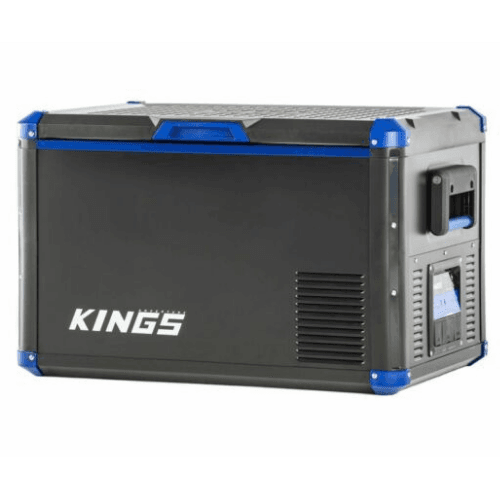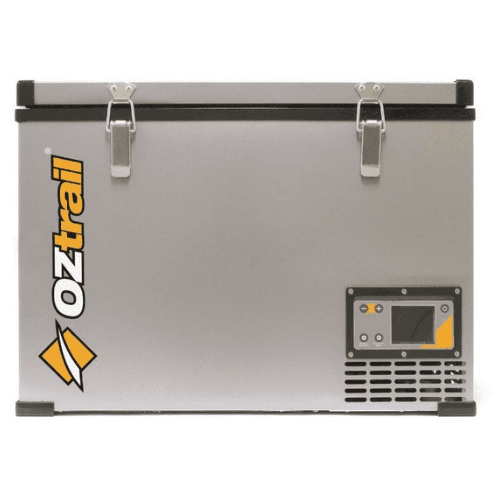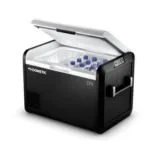Top Pick for
Overall camping freezer

Top Pick for
Overall camping freezer

Top Pick for
Affordable camping freezer

Top Pick for
Portable camping freezer

Top Pick for
Large camping freezer

Our editorial team selected the portable single zone fridges on this list based on several factors. This includes the average customer rating at established ecommerce sites like Amazon and eBay, the opinions of other professional review sites, and our own personal experience and tests.
Read more detail on our methodology below.
An esky full of ice will only get you so far in Australia. Our great distances and frequently extreme weather conditions ensure even simple tasks like keeping your meat fresh and your beer cold is out of reach. And warm beer is simply un-Australian.
As such, there are plenty of handy uses for a portable fridge. Camping, one of Australia's favourite pastimes, is the most common use case – whether you're doing The Lap or just enjoying a weekend away with your family. But they're frequently handy for other needs too. Keeping your lunch fresh when on the job, drinks cool for the team on game day, a cold one on hand during a 4WD adventure, or even just extra storage ahead of Christmas lunch, the list goes on.
So, what are the best portable camping fridges in Australia and what do you need to consider when making your purchasing decision?

Perhaps the most revered of the portable camping fridges in the Australian market is Dometic. These iconic fridges were previously referred to as Waeco, but have rebranded in recent years. As such, older models still bear the Waeco name, so don't let that confuse you.
The Dometic CFX3 55L, as well as its sister models in additional capacities, ticks all the boxes you might expect from a premium portable fridge without innovating. The design is particularly robust, with a squat shape that has reinforced corners and very strong handles. It feels unbreakable. The lid can also be fully detached and turned around if that suits your needs.
The HD display panel has been improved over previous models allowing you easy access to everything you need to know via soft-touch buttons. You can control it all via a Bluetooth enabled app on your phone and we particularly like how the app alerts you if one of your kids has left the lid open!
You can power your phone and other devices through the singular USB port and the whole Dometic CFX3 55L itself can operate happily under solar power.
More importantly, Dometic's own VMSO3 compressor, which intelligently varies its speed depending on the situation, runs great in all conditions. It even allows you to drop as low as -22ºC if outdoor conditions are compliant. This newer model extends the evaporator around the inner walls helping to ensure even cooling of the contents.
We mentioned that the Dometic doesn't really innovate, but there is a model that is an exception. For around $150 more you can get the 55IM, which is essentially the same fridge except for a handy distinction. The 55IM sacrifices about 2 cans' worth of space to include an ice maker. Yes, IM stands for ice maker. This allows you to create ice for your drinks and cocktails with ease, but it's hard to justify the extra cost. Especially as it draws a lot of additional power. It's optional and can be removed, bringing the capacity back up to 55L.
Save on Dometic CFX3 55L

Similar in production quality to the Dometic range, the Engel series offers premium portable fridge solutions that opt for a metal rather than plastic exterior. This makes it a little bit more robust for brutal travelling experiences such as off-road four-wheel driving. It has plenty of strong tie-down points too, and the large stainless-steel latch is even lockable.
It's powered by an efficient and reliable Sawafuji compressor, which is why it also comes with a great 5-year warranty. It's all controlled by an easy-to-use, if unspectacular, control panel, although it's a shame that there is no companion app support.
You'll be hard-pressed to find any bad user reviews on this product. The only consistent complaint is its weight, which at 33kg unpacked in just the 60L model is extreme. But that's what you get when you build with durability in mind. We also think the design is rather utilitarian, even if the ventilation and squat design helps with efficiency. Although, it's worth noting the fridge is too squat to hold a bottle of wine standing upright.
Engel has a powerful legacy in Australia. Your parents were probably using an Engel. Many people have decades-old Engels that have never died too. That kind of reputation comes at a cost.

If you're looking for a solid single-zone fridge freezer on a budget, Adventure Kings is well worth considering. It uses the highly regarded SECOP compressor, which we see in many of the higher-end brands. This gives you some extra assurance that it will deliver the goods on the road and you'll get some life out of it.
However, elsewhere the quality isn't as compelling. The lid, while reversible, isn't as well-insulated and sealed as the top of the range options. Indeed, the overall build quality feels a bit cheap (as you might expect from the price), while the control panel, handles (which stick out considerably) and even just the presentation are all very simplistic. Plus, many users complain of poor customer service when things go wrong.
At least inside the fridge there are 2 distinct zones to help you separate your food and drink, as well as a basket divider to help you get a third zone happening.
It's a case of you get what you pay for with Adventure Kings. It's a basic entry-level portable fridge, but with the reliable SECOP compressor doing the bulk of the work, it's still a strong contender in the budget range.

The defining feature of the latest range of Companion fridge freezers is the removable 42amp/h lithium battery. You can take the entire battery out of the fridge at your leisure, easily charging it at home or on-site, and then place it back in the fridge for the best part of a day's running time without any additional power supply. It also acts as a charging station for electronics, or a backup if your other batteries go flat.
In addition, it has a built-in Anderson Plug, allowing you to directly connect solar panels – assuming they have a solar regulator built in – to the Companion 60L fridge to help support that lithium battery. The dual-speed SECOP compressor is also not to be sneezed at, offering some big brand reliability.
There's plenty to love about the Companion fridge's design: multiple USB ports for charging, a top-lid that can open both ways, a nice digital control panel, tie-down graded handles, built-in bottle openers and even a little storage compartment. However, it is bigger than comparable fridges thanks to the battery, so that's something consider.
A fridge that wins big on innovation.

It's worth noting that you will come across an alternate model of the Companion 60L fridge freezer. It's about $600 cheaper and for obvious reasons. It stays within the expectations of your traditional portable fridge freezer without the innovation of its big brother. It doesn't offer the removable rechargeable lithium battery, the multi-opening lid system, the USB ports or the Anderson Plug. Plus, it scales back – but not much – to a dual-speed LG compressor.
However, it remains an excellent option for campers looking for a portable fridge in the budget price range. The great control panel, soft close lid, well-insulated shell, low power consumption, 3-year warranty and 3-stage battery protection are features we usually expect in higher price ranges.
It also features sturdy metal construction and tie-down graded handles. The handles are a bit hard on the hands, but they do have a low profile, allowing for easier backing in a loaded vehicle or trailer. Also note that the metal exterior gets very hot quickly in direct sunlight and while we were still impressed by how it performed in these conditions, we'd recommend getting the cover to go with it.
You can read our extensive Companion 60L review for more information.

This intriguing entry in the portable fridge space hasn't changed too much over the years, taking the "if it isn't broken, don't fix it" approach. It really stands out thanks to a unique feature. There is only 1 model – the 35L. However, you can buy extenders that increase the size from 35L to 45L, and then from 45L to 52L. You can buy all sizes together in a single kit too.
This approach gives you the flexibility of resizing the Bushman Original Camp Fridge depending on how you are using it. Just going on a day trip? Well, you can take it in its 35L form and save on power consumption and space. Doing a long weekend? Go the full 52L so you can pack in plenty of food and drinks. The system for connecting the different capacities works really well.
The Bushman is very much about function over form. It's an ugly looking fridge with an outdated control panel and no modern fringe benefits, such as USB ports or comfortable handles. But the SECOP compressor ensures durability and performance, and we also love the 3-basket interior that helps with organising your food and drink in a smart and useful way.

Another solid all-rounder, the EvaKool TMX Travelmate fridges are known for delivering great performance in hot conditions and for running quiet thanks to a low draw power mode that can be activated when conditions allow. It comes with a handy USB port, Wi-Fi connectivity, a removable basket and a sturdy design highlighted by corner bumpers and a low profile.
However, it's worth pointing out that the handles aren't recessed into the shell fully, meaning it can catch on things when packed. Also, the included basket has a rather wide mesh, with openings that can see smaller items slip through. This is a shame, as otherwise the internal layout – which divides into 3 zones – is handy.
Yet there is more to like than dislike with the EvaKool MX65. The lid can be opened either way without having to lock it in one way or the other, allowing for greater accessibility. And with its trusted SECOP compressor, as well as a class-leading, comprehensive 5-year warranty, the EvaKool TMX65 Travelmate portable fridge represents good value for money.
In short, you get plenty of premium features at a medium range price with the EvaKool. It would be remiss of us not to point out that some people have had compressor failures shortly after purchase, putting question marks over the company's quality assurance system. However, EvaKool is quick to react with replacements.

As its name suggests, the ARB Elements portable fridge is built for a life outdoors. It's well-suited for campers and travellers who are likely to store it in the tray of their ute or in a trailer. It's waterproof and dustproof, is built out of stainless steel, and has an optional mounting kit to keep it from bumping around. We also like the gas-loaded lid arms, which keep it up of its own accord. Plus, it has a lockable magnetic seal, using a 3-digit code on the nicely designed control panel.
Its robust design comes at a bit of cost. It's a sizeable fridge for its capacity and considerably heavy, and it's disappointing that the tie-down straps, which are a key accessory given the ARB Elements use case, aren't included. It's also interesting that you must open the fridge to access all the control options, which could annoy some people.
Speaking of annoying, its squat shape is also restrictive on storing tall items like wine bottles.
The ARB Elements does use a reliable SECOP compressor and comes with a 3-year warranty. The use case is very specific, though, which is a shame as it's a great looking fridge. There is only the singular 60L option. It's also worth noting that they're not too easy to find, with your best bet being a direct purchase through a physical ARB store.

The Oztrail 45L portable camping fridge looks to fit into the upper range of the budget price tier while offering a sturdy metal exterior. It's got a simple but functional design with utilitarian handles that double as tie-down points, as well as a nice big control panel and sturdy lid clip mechanism. It runs off the solid LG compressor and is relatively quiet, but it isn't top tier and the 2-year warranty reflects that.
While the Oztrail 45L camping fridge is suitable for use with solar panels, the metal fridge itself isn't the best insulated option on the market. Many users often look to spend on the additional cover to help improve that insulation for greater efficiency. Another complaint has been a loose 12V power socket that can detach easily.
The Oztrail 45L lacks the bells and whistles of the medium and top priced fridges, but that does mean it weighs a lot less than most metal portables. For those on a budget, it's a more-than solid option that will complete its core job without doing much else.

This curiosity in the portable camping fridge space comes jam-packed with features, many of which we only see in much higher-priced models. Indeed, this is on the lower end of the budget range when it comes to price. Yet you get a USB port, Bluetooth app control, built-in bottle opener, a (basic) LCD control panel and a 3-year warranty.
It also comes with wheels and a telescopic handle, which makes it a lot easier to move about for campers who think they'll struggle with the weight of a loaded fridge. Plus there is an optional internal battery backup as well as solar support.
So why the cheap price then? Well, it doesn't use a known-name compressor, which puts some question marks on reliability but also shows up in a higher than normal power consumption. The vertical design is cramped, making it hard to get access to food and drinks buried at the bottom.

Coming in at the mid-range price point for a portable camping fridge is the myCOOLMAN 60L model. It's a bit on the bulky side, but there's still a lot to love about its design. The excellent handles are recessed into the wall of the fridge, preventing it from getting caught during packing. Bottle openers on either end are also embedded in the handle bay, while the nifty little control panel is also tucked inside the chassis.
This fridge's low profile makes it great for packing into tight spaces. While the reversible lid and power inputs at both ends, including a USB port, give it added flexibility when packed. Inside, the smart basket design allows for 3 separate compartments, although the large mesh can make balancing bottles cumbersome. Bluetooth wireless connectivity to an app is also appreciated.
The myCOOLMAN range uses the German company's own Blue compressor, so you're taking a bit of a punt there in terms of reliability and repair, but the 5-year warranty certainly gives you confidence. The compressor also comes with a Turbo mode, that allows you to get your fridge to temperature quickly – handy when you are still plugged into your mains before leaving home.
The myCOOLMAN portable camping fridges are a new face on the Australian scene, but early indications are promising. There's plenty of bang for buck here, and there are some nice additional accessories you can grab, including a magnetic lithium power pack that offers a great back-up power supply.
List of brands considered:
We carefully collected data from each review to identify recurring pros and cons for each product based on category-specific criteria such as performance, insulation, design, features, weight, reliability, customer service and more. Volume and quality were also factored into our shortlist, as well as value for money.
Finally, we corroborated our choices with other professional review sites to identify any anomalies, as well as factoring in our own experiences with the products.
We value our editorial independence, basing our comparison results, content and reviews on objective analysis without bias, but Finder may receive compensation when you click links on our site. Learn more about how we make money from our partners and why you can trust our guides.
A camping fridge is a portable version of a traditional household refrigerator. These fridges are made to be taken on the road so you can keep your food and drinks cold on your next camping trip.
While a portable fridge can keep items cold or frozen – and in the case of dual zone fridges, both – for long periods of time without you having to refill it with ice, they aren't cheap. If you are looking for a way to keep your food cool without spending much or only camp occasionally, consider buying an esky instead.
The lifespan of your fridge will depend on how regularly you use it, the strain you put on the compressor and how well you take care of it. Many fridges come with 1-year to 3-year warranties, but some stretch to 5 years. The premium brands have lasted families for decades.
When you first begin researching portable fridges and freezers, you'll come across two core variants: single zone and dual zone. These are as you might expect from their nomenclature: a single zone fridge has the one compartment and a dual zone has two.
The benefit of a dual zone portable fridge is that one compartment can act as a fridge while the other can simultaneously behave as a freezer. This is obviously very handy on your longer camping or 4WD trips where you can potentially spend significant periods of time away from civilisation. But they're also bulkier, heavier, demand more power and cost a lot more.
On the other hand, you have single zone portable fridges. These offer more flexibility for day-to-day use or weekend trips. They're typically smaller, cheaper and more efficient to run. And just because they're single zone doesn't mean they can't double as both a fridge and a freezer. Most models allow for both use cases. The downside is you can only do one or the other at any one time.
You may have come across the term combi used to describe some portable fridges. This refers to a single zone portable fridge that can act as either a fridge or a freezer. As in, it behaves like a combination of the two, but can only act as one or the other at any one time. Most single zone fridges you come across nowadays are all combi fridges.
You'll come across three different approaches to powering the portable camping fridges in Australia. The "way" in the naming of these approaches refers to the number of ways that the portable fridge can be powered.
You're unlikely to come across a one-way portable fridge, as they're not awfully portable. The one way you can operate these fridges is by a 240V AC mains connection. As in, just like your home fridge.
| Pros | Cons | |
|---|---|---|
| Compressor (two-way) fridge |
|
|
| Absorption (three-way) fridge |
|
|
You'll come across one-way and two-way portable camping fridges also referred to as compressor fridges. They run in a similar fashion to the fridge in your kitchen, pumping cold air into your single zone fridge. They're designed to work primarily off a 12V connection and as a result, are the most efficient option if this is your most likely energy source. The compressor can ensure a desired temperature even in extreme external conditions, too. However, they can be noisy to sleep next to.
A much quieter option is a three-way fridge using LPG gas, which is near silent. These are also known as absorption fridges, as rather than focusing on pushing cold air into the single zone, they pull hot air out via a heat exchange. They're not as good at distancing internal temperature from external temperature as a compressor model. However, if you're heading on a long trip away from a power source, then a 9kg gas bottle can potentially power a three-way fridge for weeks.
Much smaller fridges offer a thermoelectric cooling solution. They also work via heat exchange, except do so via electric conductors. These are much lighter and cheaper than the two other options, but they're also limited in what they can achieve. They can't freeze your contents, and don't deal well with heat extremes. They tend to be found in the range of very small capacity, super portable fridges of 20L and less. Their use case is for day trips where they spend most of their time in air-conditioned cars.
A bigger fridge does not always mean a better fridge. When choosing the right size fridge for you, consider the following five details:
Fridges are typically measured in litres, but fridge capacity is often described by how many cans a fridge will hold. To help you decide on the right fridge size for you, we've compared the approximate storage capacity of common fridge sizes.
| Size | Approximate storage capacity | Who is it good for? |
|---|---|---|
| 25L and under | 27 cans | These ultra-portable fridges are suited for individuals and can store small amounts of food or drink for picnics, lunches or day trips. |
| 35L | 47 cans | 35L fridges can typically hold enough food for two people for a weekend of camping. |
| 40L | 60 cans | 40L is the most popular size for camping fridges and is considered the "standard" size. These fridges can typically hold a weekend's worth of food and drink for a family of three. |
| 50L | 72 cans | 50L fridges can hold a week's worth of food and drink for two people or a long weekend's worth of food and drink for four people. |
| 60-65L | 106 cans | 60-65L is considered the minimum size for more than a weekend's worth of food for four people. This size fridge can also hold drinks and snacks for a team. |
| 80L and over | 120 cans | A group of people needing food for a week or longer should consider an 80L fridge at a minimum. |
Most of the major brands you'll come across when considering portable fridges will offer multiple sizes. The bigger the fridge the more you can store in it. That's obvious, right? And chances are no matter what size you get, you'll always want that little bit more space.
But while opting for a bigger portable fridge size will give you the ability to keep more stuff cool or frozen, it comes at a cost. And not just a monetary cost. Bigger fridges require more power to run and they take up more space. But perhaps more importantly, they weigh a lot more, especially when they are made of metal.
A big portable fridge freezer filled to the brim with your drinks and edibles can take two sturdy humans to move. And even then, it's hard on the back.
Generally, the smaller capacities, say, less than 40L, are better suited to day-to-day use. Fridges that sit in cars when you're out on the job, for example. Or keeping a couple of cans cold for the end of the game. That kind of thing.
Singles or couples looking to go on long weekend camping trips may look for something in the 40L to 60L range. These can comfortably hold key food items and enough drinks for two. Plus, they remain portable enough to move in and out of a car after only a few days.
Families or those looking at much longer trips where a considerable amount of food and drinks may need to be kept cold or frozen at any one time may want to invest in the greater storage space. Maybe even up into that 80L+ range.
Naturally, single zone fridges weigh less than dual zone fridges at the same capacity. This is because the dual zone has a dividing piece of chassis, increasing its bulk.
Make sure you take a good look at the average power consumption, usually between zero and five amps, of the portable fridge you are considering. This indicates how much current the fridge freezer will pull to operate. The more current it pulls, the more power it needs. If you intend to rely heavily on 12V power, in particular solar power, to operate your portable fridge, then this can be an important consideration.
Talking of efficiency, also look at the compressor brand of two-way fridges. The bigger names, like LG, SECOP (previously called Danfoss), Dometic and Sawafuji, will likely give you better results and longer warranty periods.
Also, be conscious of what plugs come with your portable fridge. Ideally, an Anderson plug is more robust at handling a high current draw, which you get with a fridge, and tends to stay connected better than a stock-standard cigarette lighter plug.
If you're buying a portable single zone fridge freezer then it's highly probable you will be using it outside and away from home. They need to be designed to insulate themselves well from the external elements if they are going to efficiently go about their work. It's worth paying attention then to what insulation and durability features a portable fridge freezer offers.
If insulation is your most critical consideration, then you should look towards fibreglass fridges. These not only offer the best protection from the elements, and therefore efficiency, but also don't absorb smell so are easier to clean. However, it's more brittle and less likely to survive bumps and bruises. Plus, there isn't as wide a choice of options in the marketplace.
Plastic is a good all-rounder. It has decent strength that's able to take most impacts with ease and solid insulation performance.
Metal isn't the greatest for insulation, but its easily the most durable. If you're expecting a rough-and-tumble experience for your portable fridge, for example, a lot of off-road 4WD adventures, then it comes into its own.
On durability, it's also worth checking for any weather resistance features and looking at how the lids not only close, but clasp together. The last thing you need is the fridge lid opening every time you hit a bump in the road. Or a clasp breaking when you are in the middle of nowhere.
We've covered the most important separators you will want to consider when comparing the best portable camping fridges and freezers, however, there are plenty more you'll come across. The greater the number of features, generally the bigger the price, of course.
Shape. How do you intend to store your portable fridge freezer for travel? If it's going in a low-sided trailer or under a tray in your boot, you may want something wide and flat rather than thin and tall, for example. With bigger portable fridges, you may also want recessed handles so they don't catch on other items.
Wheels. As mentioned earlier, the best portable fridges can get quite heavy when loaded up. Good, sturdy wheels can be quite a boon if you need to move it around your campsite a bit. For example, to keep it in the shade as the sun moves.
Baskets. Especially with single zone fridge freezers, baskets are a handy way to separate items as they cool. This can prevent you from having to fumble around through your food to find the last cold beer, for example. Or to separate soft foods from hard foods. Are there baskets that come with your fridge and if so, are they an added expense? Do they break up zones smartly?
Mounting points. You can't risk having a loose fridge while you're travelling. If you have an accident, it could go flying and kill someone. Even little bumps in the road can shift it about, pulling it free from its plug if it's charging from your 12V car port. So, can it be tied-down easily, or even securely mounted to your vehicle or trailer?
Cover. Does the brand of fridge you're considering have a cover accessory? These aren't essential, but do add an extra insulation layer and can also provide important protection from bumps and scratches.
USB ports. A very handy option when camping is to be able to plug in electronic devices such as your mobile phone and charge them directly from the portable fridge.
Removable or reversible lid. You may be wondering what the benefit is to removing the lid of your portable fridge freezer. Well, it increases access to the internal compartment, which is handy when getting baskets in and out or when packing items. Plus, it's easier to clean. And often you can reverse the lid, too, making it easier to access depending on your set-up. You just want to make sure that the mechanism for removal and reattachment is sturdy and straightforward.
Digital display. It's one thing to think your fridge is behaving well, and it's another to know the exact temperature inside, battery consumption and other details. Most modern portable fridges will have LCD screens that display this information.
Wi-Fi or Bluetooth. Following on from the last point, being able to connect remotely to your fridge from your smartphone is a great way to keep on top of its performance.
Accessories. Can you upscale your portable fridge in useful ways? Covers, slide-out trays, solar cables, lithium back-up batteries, Anderson plugs and additional baskets are just some of the accessories you'll likely look into during the lifetime of your portable fridge.
The best portable fridge brands share some common traits. A reliable compressor. Smart robust design. Low power draw. Good warranties. Tight seals. And usually bonus features like USB charging ports, reversible lids, Anderson plugs and even lithium back-up batteries. The bigger brands often have multiple models at different price points, too. But as a rough guide, these are the best brands at each price tier:
Premium tier
Medium tier
Budget tier
The harder a portable fridge needs to work to reach the desired temperature, the more power it uses. Work can be defined by the difference in temperature outside the fridge compared to the desired internal temperature of the fridge. More expensive portable fridges and those from the bigger name brands tend to have more efficient cooling systems, it's true. But there are plenty of other factors you can control to help improve your fridge freezer's efficiency.
When choosing a camping fridge, consider your budget, the size of the fridge and any additional features you may need. You will also need to decide whether you want a fridge, a freezer or both.
The price of camping fridges generally ranges from $350 to $2,000 depending on the type, size and brand. The average cost for a standard 40L fridge is between $800 and $1,300. If you need a secondary power source or additional accessories, remember to include them in your overall budget.
Many camping fridges can operate as fridges or freezers, but not at the same time. Some dual zone models can do both simultaneously.
Many manufacturers consider the compressor to be the most important part of the fridge. A compressor from a reputable brand should come with a warranty.
The better the insulation of the fridge, the less stress there will be on the compressor. Look for fridges with thick insulation and consider using an insulation cover to protect the fridge.
Power consumption indicates how long a fridge will run when connected to power and how much time it will take for the fridge to drain your battery. Power consumption is measured in amps per hour and typically ranges from 1a/h to 5a/h for camping fridges. A low 1a/h or 2a/h fridge is an indicator of a low electric draw and longer battery life.
Battery protection protects your battery from being drained or damaged by your fridge and helps ensure you won't be left stranded due to a dead battery.
If you plan to use your fridge off-road, make sure to look for fridges that have multiple tie-down points and shock minimisation.
Your fridge should be durable enough to withstand any trips you plan to take. As a guide, an average-sized adult should be able to stand on the top of a sturdy fridge without damaging it.
Look for a fridge with a thermometer that allows you to control the temperature of the fridge and freezer.
| Engel | 7.9 | 4.38 | 4.25 | 4.25 | 4.34 | 4.44 |
|---|---|---|---|---|---|---|
| Bushman | 7.86 | 4.2 | 4.44 | 4.32 | 4.2 | 4.2 |
| Yeti | 7.71 | 4.36 | 3.82 | 3.82 | 4.27 | 4.09 |
| Adventure Kings | 7.66 | 4.25 | 4.17 | 3.92 | 4.17 | 4.04 |
| ARB | 7.53 | 4.18 | 3.88 | 4.06 | 4.18 | 4.18 |
| Dometic | 7.51 | 4.14 | 4 | 4.24 | 4 | 4.14 |
| Other | 7.48 | 4.09 | 4 | 3.91 | 4 | 3.91 |
| EvaKool | 7.32 | 4.05 | 4.1 | 4.05 | 3.95 | 3.76 |
| Oztrail | 7.19 | 3.9 | 3.81 | 3.95 | 3.81 | 3.86 |
| National Luna | 7.18 | 3.82 | 4 | 3.91 | 4.27 | 3.91 |
| Chescold | 7.13 | 4 | 3.61 | 3.94 | 3.56 | 3.78 |




These are the seven best freezers you can get right now in Australia.
Does the addition of a removable lithium battery make the Companion 75L the best portable dual zone camping fridge in Australia?
From the best energy-efficient option to the top cheap model, these are the 10 best French door fridges available online.
With great performance and a durable metal design, the Companion 60L portable fridge is a top buy when camping on a budget.
From the best small option to the top energy-efficient model, these are the six best top mount fridges you can buy online.
These are the 9 best bottom-mount fridges you can buy right now in Australia.
With a 5.5-star energy rating, this might just be the most eco-friendly fridge on the market.
These are the 9 best wine fridges you can get right now in Australia.